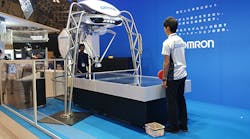CHIBA, Japan — A pingpong-playing robot, a flying origami bird and a mirror that some might find a little too honest for comfort were on display at a huge tech show in Japan on Wednesday.
The gadgets are all part of this year’s Cutting-edge IT & Electronics Comprehensive Exhibition (CEATEC), Asia’s largest electronics fair, just outside Tokyo.
Prominent among the pack was a robot arm made by automation parts maker Omron that can play — and coach — humans at ping pong.
“Immediately after the player hits the ball, the location of the robot’s return ball is displayed on the table-tennis board, helping the player’s next return,” spokesman Masayuki Atsumi said.
The robot uses both a camera and an array of sensors to detect the balls movement and play a near flawless rally, though Omron is not marketing the robot for sale. The same technology can be used in vehicles to avoid collisions, said the company, which is known for its healthcare products.
High above attendees, the sound of flapping wings could be heard. Rohm, a major maker of semiconductor devices and other electronic parts, had managed to create a foot-long origami crane bird — weighing just 31 grams — that can fly thanks to an ultra-light motor.
“Making everything light was a difficult part in developing this,” spokesman Takumi Furukawa said.
The same company has also invented a sensor that can be placed in luggage to reveal whether suitcases get bashed around by handlers during flights — and reveal a suitcase’s location should it get lost in transit. Furukawa said the sensor was a prototype that they hoped could be commercialized by a luggage manufacturer.
Electronics giant Panasonic also displayed its vision of what a high-tech home could look like, complete with a variety of gadgets and appliances that communicate with each other. That includes a mirror which, when hooked up to the rest of the gadgets in the home, can display your body mass index (BMI) — a measure of body fat based on height and weight – when a user sits down in front of it.
The mirror can also gauge how healthy your skin is as well as overlay virtual cosmetics on a user’s face to help guide their morning make-up routine after a regret-tinged night on the tiles.
The same home also boasted a dining room table and window which can react to conversations — displaying, for example, images of a recent trip a family might have taken once they start talking about it.
Company spokesman Daisuke Uehara said the presentation was an idea of what a home might look like in 2018-20.
“There are no concrete commercialization plans but we already have this technology to realize if customers wanted it,” he said.
About 530 companies are taking part in the trade show, around one-quarter of them foreign exhibitors from 19 countries and regions, led by China, Taiwan and the United States.
By Kyoko Hasegawa
Copyright Agence France-Presse, 2015



